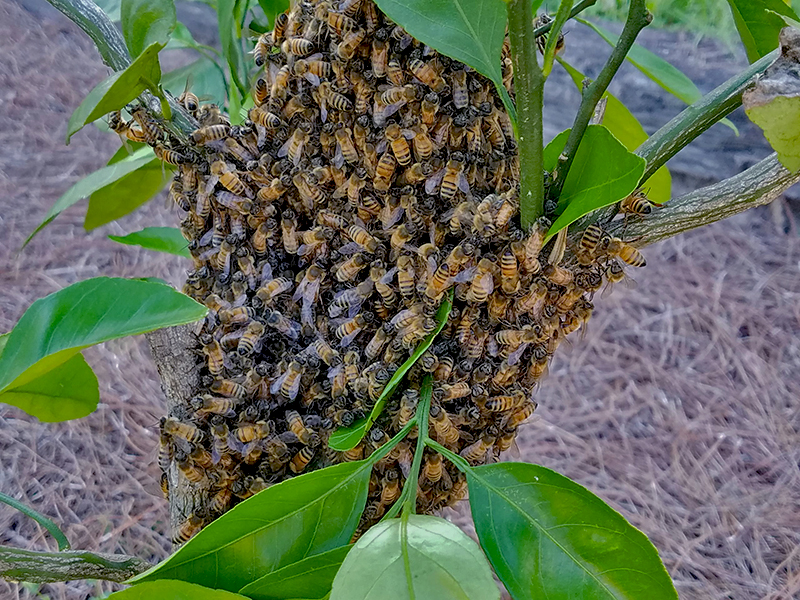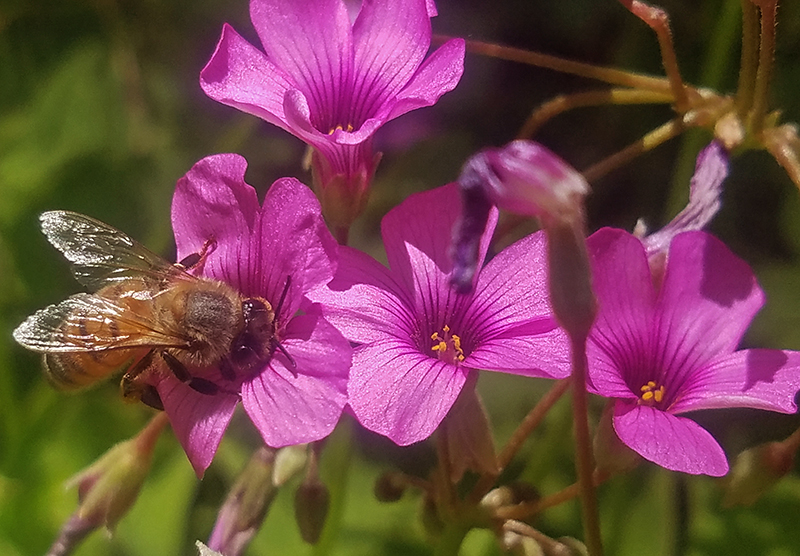The European Honeybee, Apis mellifera, is not native to North America but it is a very common sight here. Awareness of the importance of this species has risen in recent years as new threats to the well being of our honeybee population arise. Important as bees are, they sometimes exhibit behaviors that can make them a nuisance or even frighten people. Whether nesting in the walls of a house or forming a large clump on a nearby tree, these hard-working creatures can find themselves unwelcome by home and landowners.
Understanding the nature of honeybees can help to shed some light on why this can occur. Honeybees, as it happens, are eusocial organisms; that is, individuals have different jobs in their group, and all work together for the sake of the survival of the entire colony or hive. Certain members of the group are responsible for reproduction, others for gathering food, caring for brood, defense of the hive or colony, and more. Other insects that exhibit this sort of social existence include ants, wasps, and termites.
This means that a hive of bees can be understood as a sort of superorganism, in that any individual bee cannot thrive alone. A queen bee, finding herself alone, may be able to reproduce, but will starve from lack of food. A worker bee may be able to feed itself, but cannot lay eggs to produce further generations. A male drone does not forage for food, has no stinger to protect himself or the hive, and cannot reproduce by himself. Alone, he is as useful as a chocolate teapot, though much less delicious.
While the queen is responsible for reproduction of individual bees, the hive itself also needs a method to reproduce as a whole. Bees accomplish this by forming swarms. A swarm happens for a number of reasons, but a crowded hive is an important one. When there is no more room left for the hive to grow, it splits. The old queen is put on a diet by the worker bees, causing her to lose weight, making it easier for her to fly. Workers gorge themselves on honey as a supply for the new hive. New queens begin to develop in the old hive. Half to three-quarters of the worker bees take the old queen and leave to find a new place to live.

Bee swarms may rest on a tree branch while they are looking for a new home. They will soon leave by themselves. Credit: Evan Anderson, UF/IFAS
When does this occur? Typically in the spring, when flowers are blooming and nectar is flowing. This can be a source of concern for both beekeepers and homeowners. Beekeepers don’t want to lose half their bees, and homeowners don’t want to suddenly find them living in their yard or worse in the walls of their homes.
For beekeepers, there are things that can be done to prevent swarms:
- Provide adequate space for expansion of each hive
- Move brood or food combs from stronger to weaker hives
- Replace the queen in hives that may be prone to swarming
- Clip the queen’s wing so she cannot leave with the swarm
- Check hives weekly and remove queen cells
For homeowners, there are only a few options, if a bee swarm is found on their property. If the swarm has not yet chosen a home, a beekeeper may be able to catch them before they settle in. Even those bees who have begun to build a new hive may be removed, if they are in an accessible area. Check with a bee removal specialist to see if the swarm can be safely (and economically) removed. If removal is not an option, Florida law does allow nuisance bees to be eradicated. However, this must be done by a Certified Pest Control Operator.
More information on bee swarms and their management is available on the University of Florida IFAS Extension’s EDIS fact sheet website:
Swarm Control for Managed Beehives
European Honey Bee Apis mellifera Linnaeus and subspecies
Choosing the Right Pest Control Operator for Honey Bee Removal: A Consumer Guide
The Florida Department of Agriculture and Consumer Services also has information on the subject, as well as a list of local bee removal companies:
Bee Removal or Eradication in Florida
- When Grasses Collide – Centipede vs. Bahiagrass in Your Pasture - August 26, 2022
- Time to Think About Pond Weeds - March 18, 2022
- Avoiding Pesticide Resistance - September 24, 2021

